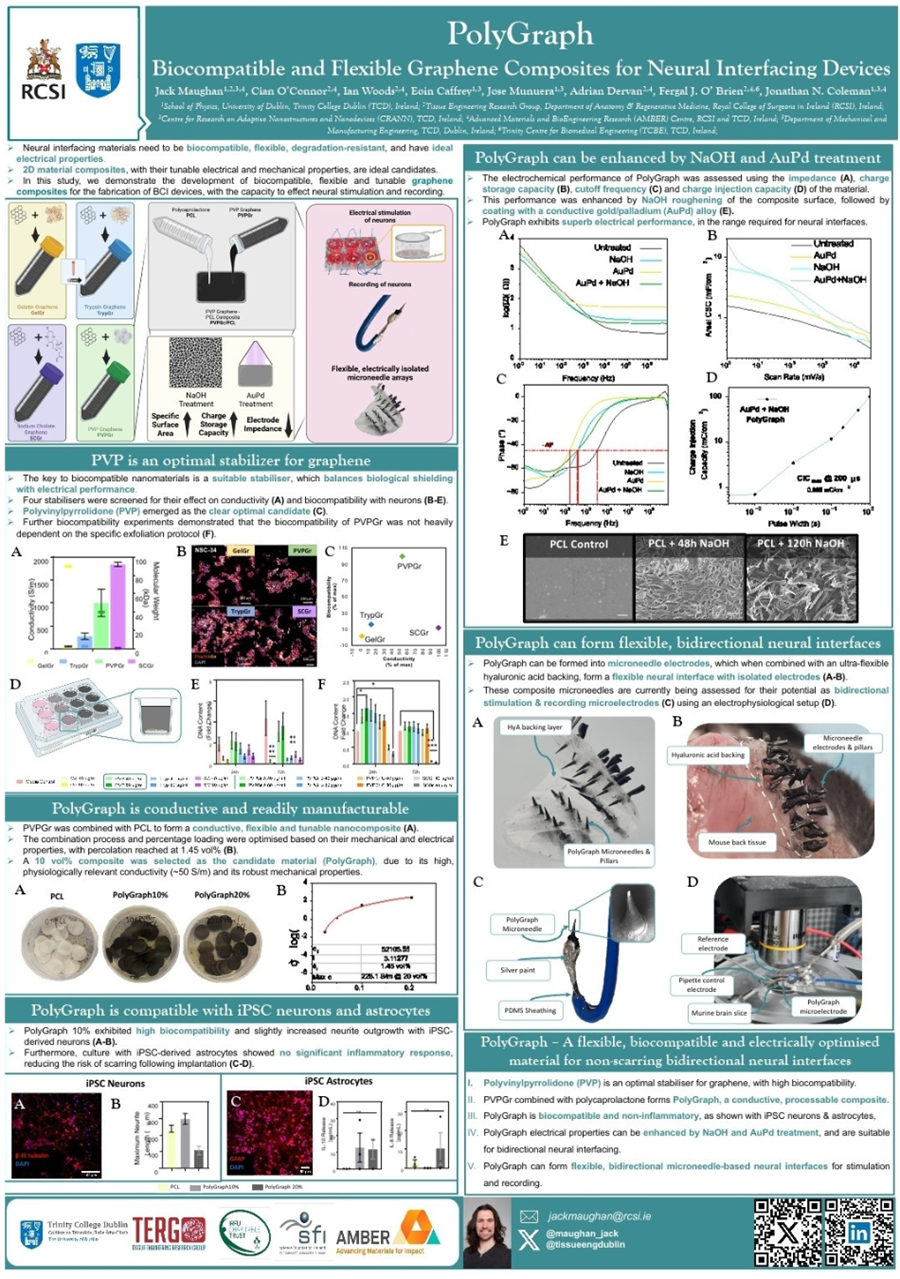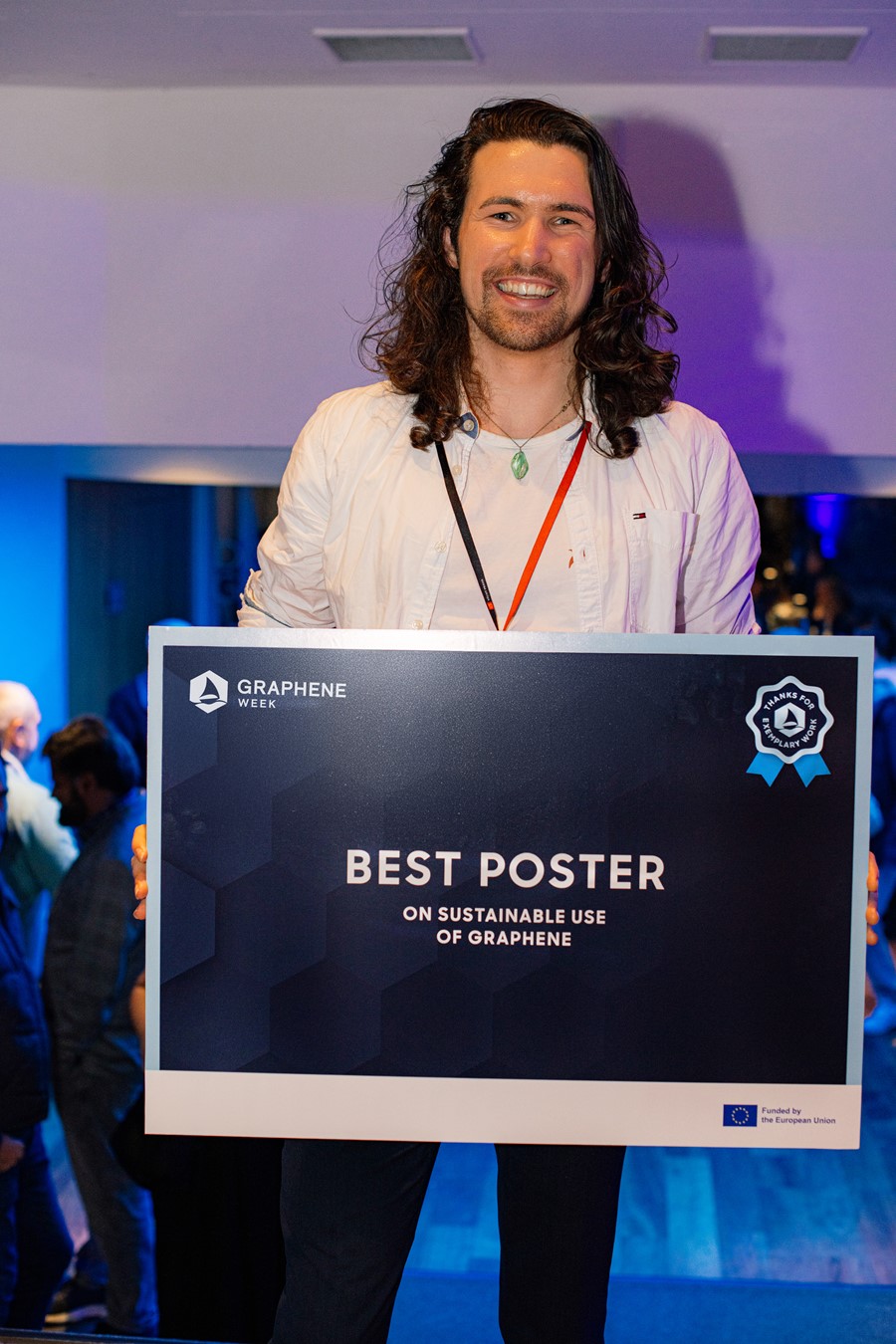Jack Maughan’s Work at the Edge of Graphene and Neuroscience
At the crossroads of cutting-edge materials science and advanced biomedical engineering, Jack Maughan is building tools that could reshape how we treat and interact with the brain. A postdoctoral researcher with a background in nanoscience and tissue engineering, Jack is exploring how graphene-based microneedles can enable next-generation neural interfaces devices that could one day treat neurological disorders, restore movement, and even enhance human-machine communication.

This work is targeted at enhancing the capabilities of neural interfacing devices by offering an adaptable material with softness, conductivity and biocompatibility."
Poster Award Winner 2024

Biocompatible and Flexible Graphene Composites for Neural Interfacing Devices
By: Jack Maughan
Best Poster on Sustainable Use of Graphene 2024

It seems like a hidden hack to turn an ordinary material into something extraordinary."

This future vision gives me a lot of energy to continue pushing on the sometimes quite challenging day-to-day science!"
How did you first start working with graphene/2D materials?
I got into working with these materials during my undergrad, studying Nanoscience – my first exposure was to CVD-synthesised graphene in the Max Planck Institute for Solid State Research in Stuttgart. I then returned to Ireland, and started my PhD in the biomedical applications of 2D materials – I've been hooked on them ever since!
Why are you excited to work on graphene/2DM?
I've always been fascinated by the idea of unlocking a wide range of new properties by changing the dimensionality of a material – it seems like a hidden hack to turn an ordinary material into something extraordinary. With reference to the biological side of things, the strides that can be made in biotechnology when a new material is discovered can be quite profound, and 2D materials have really shaken up the space.
Who has been the biggest influence or mentor in your career so far?
That would have to be my supervisors, Prof. Jonathan Coleman in Trinity College Dublin, and Prof. Fergal O'Brien in the Royal College of Surgeons in Ireland – their willingness to collaborate across disciplines is where my PhD came from in the first place, and their support and guidance throughout my PhD has been invaluable. It's also inspiring to work with people who have such a strong grasp of the big picture, with a focus on how these materials can benefit people in real, tangible terms.
How did you first become interested in your current research project?
When working initially on graphene, we focused on nerve regeneration, but following the conclusion of that project, wanted to leverage what we'd learned about graphene stabilisation and composite manufacture to investigate higher-resolution devices for neural interfacing. This led to our pursuit of flexible composite microneedle-based electrodes for neural interfacing devices, my current research project.
What’s your research focus? What is your current research goal?
My current research focus is the use of graphene-based composites for neural interfacing applications in the form of microneedle electrodes, joined by a flexible extracellular matrix backing. This work is targeted at enhancing the capabilities of neural interfacing devices by offering an adaptable material with softness, conductivity and biocompatibility.
In what way can graphene and other 2DM improve this area?
Graphene in particular is ideal for this application, thanks to its conductivity, biocompatibility, and ability to change the properties of polymers when fabricated into composites. When mixed with a polymer, conductive composites that can deliver signals to or record signals from neurons can be formed, and readily adapted to a given application by changing the polymer, the amount of graphene added, and the processing techniques.
Why do you feel your research is important, and what benefits could it bring to society?
In the short term, this work offers the potential to revolutionise therapies for a wide range of neurodegenerative and neurological disorders, such as epilepsy and Parkinson's, as well as potentially profound impacts on the mobility and communication of those suffering from paralysis and other motor dysfunction. In the longer term, these devices could transform how we interact with the world around us, how we engage with our devices and with each other, by the development of advanced bidirectional neural interfacing capabilities.
As an early career researcher, where do you see your field going?
I believe that research in this space will continue towards higher resolution, more highly flexible devices, with multiple channels designed to allow for robust interfacing with a larger portion of the brain. These devices, in the form of neural threads or flexible neural shanks, may incorporate multimodal functionalities such as microfluidics and optical stimulation in addition to electrical recording and stimulation, enabling optogenetic and chemical modulation of activity in addition to electrical modulation. In broader terms, the field is moving towards higher coverage of the brain using smaller electrodes and multimodal interfaces, enabling more accurate interfacing with the complex neural circuits of the brain, particularly those implicated in higher-order cognitive function.
What do you enjoy the most in your career path?
For me, it's the combination of both being on the cutting edge of the materials science at its earliest stage, with working on something that I truly believe has the potential to be revolutionary, that gets me going – there are few other fields I can think of that are so intoxicatingly interdisciplinary, and hold the potential for such wide-ranging impact, both therapeutic and societal. This future vision gives me a lot of energy to continue pushing on the sometimes quite challenging day-to-day science!
Do you have a favourite anecdote or moment from your research journey?
Yes, somewhat unrelated to the graphene work I've been involved in though. One of my other projects involves the use of 2D boron nanosheets for the development of multifunctional additives for bone repair scaffolds. All sounded simple, except for the issue that boron has no intrinsic layered structure along which to exfoliate! This meant that for months I was an expert in making boron nanoparticles, with only one of my exfoliations yielding anything that was even close to two-dimensional. However, this all changed one day on the SEM – we'd changed the bulk precursor to a crystalline boron powder, giving the exfoliation lattice planes to work along, and it worked! The sheer relief and joy that flowed through me at that moment was unreal, and I'm sure very much confused the med student who was shadowing that microscope session – he was likely wondering why I was so excited by what looked like little grey cornflakes on the screen. For me, this was a real lesson in persistence, in systematic experimentation, and in patience with the science, even if it feels sometimes like you're banging your head against a wall!
What is the most challenging part of your current work?
The most challenging aspect of my current work is grappling with the electrochemical behaviour of these advanced neural interfacing composites – while these parameters have been very well established for metals and conductive polymers, they are harder to find for nanomaterial composites, the complex network effects of which can make optimisation of the electrochemical parameters difficult.
If you could work on any dream project involving graphene/2D materials, what would it be?
I would love to continue this work, to really push these composite materials to their potential – seeing whether they can realistically be used for these high-resolution neural interfacing applications. There's a lot of optimisation and fundamental materials work that could be done with graphene and other 2D materials such as MXenes, and I believe that the unique properties of nanomaterial composites could, if it is possible to fully leverage them, unlock a range of possibilities currently unavailable to traditional neural interfacing materials such as metals and conductive polymers.
What are your plans for the future?
I plan to travel – both for life outside of science and to explore opportunities in the neural interfacing space. Once I finish up my current postdoc and wrap up the papers from my PhD, I'll take a few months out, before pursuing roles in the development of advanced neural interfaces that can leverage my nanomaterial and tissue engineering background.
Tell us about your experience at Graphene Week 2024. How was this event for you?
I really enjoyed my time at the conference – I found it to be a great setup for networking, with interesting questions, a great mix of topics across electronics, fundamentals, bio, and even some other 2D materials! Everything felt like it flowed very smoothly, and the quality of the talks and posters was extremely high across the board.
How did you feel about winning the Graphene Week Best Poster Award?
I was elated for my work to be appreciated, particularly at a more materials/physics-focused conference! It felt like the culmination of a lot of time at an interdisciplinary coalface, and I'm very glad that my work resonated with the judges.
Jack Maughan’s research is a powerful example of how 2D materials like graphene are opening entirely new avenues in medicine and human–machine interaction. By engineering interfaces that are as smart and soft as the tissues they connect to, he’s helping build a future where technology can truly speak the brain’s language. As the field of neural interfacing continues to evolve, researchers like Jack are laying the groundwork for devices that could one day heal, restore, and even augment the human mind.




